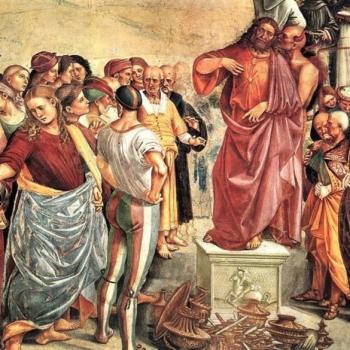Some commentators on Revelation give the Parthian empire a major role in the book. The Parthian empire stretched from the Euphrates to Iran; the Silk Road passed through, making it crucial to trade routes from the Roman empire to the far east. Romans and Parthians fought several times during the first century BC. Brutus and Cassius tried to use the Parthians for their own purposes. Mark Antony, better known for other exploits, led a Roman pushback a few years before the birth of Jesus.
Commentators see Parthians in the bow-wielding rider on the white horse in chapter 6 (Parthians were famous bowmen). They bring up the Parthians when talking about the beast’s apparent death-and-resurrection, citing legends that Nero would rise from the dead to lead a Parthian force to retake Rome. They see Parthians in the kings from the east who amass at the dried-up Euphrates in chapter 16.
There were disturbances between Romans and Parthians in the 50s and 60s AD, one over Armenia, and Roman-Parthian tensions rose again in the second century. But the Parthians didn’t invade the empire, however fearful Romans in the eastern provinces might have been. The second-century wars involved Roman incursions into Parthian territory, climaxing with the capture of Ctesiphon in 226 AD.
Craig Koester (Revelation, 657) sums up the history of Roman-Parthian relations, suggesting that the threat of Parthian invasion may be overstated by some commentators: “The Romans were the ones who invaded Parthia, only to be repulsed in 53 and 36 BCE. . . At that time some Romans thought further attempts should be made to conquer Parthia . . . , but Augustus negotiated peace. . . . During the reign of Gaius Caligula, a Parthian king came peacefully across the Euphrates to show his friendship by paying homage to the Roman standards and the statues of the Caesars. . . . In Nero’s time Rome and Parthia had disputes over borders but reached a settlement, and Nero gained favor with the Parthians by making their king’s brother the ruler of Armenia. . . . The Parthians offered to assist Vespasian during the Roman civil war, then congratulated him for his victory in Judea and even asked the Romans for military assistance – though their request was refused.” Koester concludes, “In the mid- to late first century CE there was little apparent danger of a Parthian invasion.”
So: What are we to make of apparent Parthian allusions in Revelation? Was John predicting an invasion that never occurred? Or, were allusions to Parthia a literary device to depict other, perhaps spiritual powers—the way a medieval writer might dress up demons in the garb of invading Muslims or, hypothetically, a Presidential candidate might portray threats to the Republic with Chinese or Mexican features? The answer to that sort of question reveals a lot about what a commentator thinks Revelation is about; whether, or how, it hooks into actual historical events.
Or, perhaps Koester is right and the Parthian card has been overplayed. Perhaps we should look elsewhere for the sources and significance of John’s imagery.














